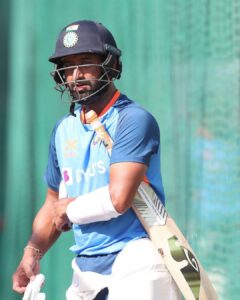
India’s No.3 was once dominant against spin bowling. But post-pandemic, there has been an alarming dip in his batting against spin. Can he now enjoy the kind of late-career renaissance that Rahul Dravid, his predecessor at No.3, did?
The biggest disservice Indian cricket did to Cheteshwar Pujara was to anoint him The Wall Mark II. In one sense, it was merely convenient, with Rahul Dravid’s career winding down just as Pujara was starting to make his way in the international arena. And it’s not that there aren’t similarities either. The Zen Master-like calm at the crease is one, as is the absence of frills while compiling runs and the utter lack of interest in the limelight.
But as Pujara prepares to play in his 100th Test, with Dravid overseeing the team as coach, it’s not hard to see that there are also huge differences in their career graphs. While Pujara has marginally better numbers (for now) on home turf, Dravid is streets ahead as an overseas batsman, averaging 53 with 21 hundreds to Pujara’s 37.4 (nine tons). In a career that lasted nearly 16 years, Dravid didn’t average less than 40 on a single continent. Pujara averages more than 40 only in Asia.
They’ve also played their cricket at times when notions of how the game should be played have undergone a sea change. Dravid was part of a generation where top-order batsmen grew up with catchphrases like ‘giving the first session to the bowlers’ and ‘taking the shine off the ball’. Pujara’s 100th Test takes place at a time when England – under the captaincy of Ben Stokes and the coaching of Brendon McCullum – are routinely scoring at six runs an over or better while registering shock-and-awe wins. The landscape hasn’t just changed, it’s unrecognisable.
One of India’s most prominent test players of modern days, @cheteshwar1. The 2nd test of #BGT2023 will be his 100th. A tribute to #CheteshwarPujara for this special milestone in his glorious career. 👇@JUnadkat @BoriaMajumdar @Wowmomo4u @BCCI #BorderGavaskarTrophy2023 pic.twitter.com/iLI8vFAeJ6
— RevSportz (@RevSportz) February 16, 2023
What has also become unrecognisable is Pujara’s batting in Indian conditions. There was a time, especially in the first five years after he took over the No.3 spot from Dravid, when Pujara was both anchor and enforcer on home turf. In 2013, when he averaged 78.42 from six Tests in India, he scored at a cracking rate of 62.81 per 100 balls. In 33 home Tests up to the end of 2017, Pujara made ten centuries and crossed 50 on another 13 occasions.
The only real dip came in 2015, when he aggregated just 202 runs in the four-Test series against South Africa. But that was a low-scoring contest on tricky pitches, and Pujara’s 31 and 77 were central to India’s victory in the first Test in Mohali.
That was then. Since the Covid-19 pandemic forced us to reassess most aspects of our lives, Pujara the anchor has become the weakest link in a shaky line-up. In the seven home Tests played since the first lockdown in March 2020, he averages a miserable 21.36, with one half-century in 11 innings. Even the spin trio of R Ashwin, Ravindra Jadeja and Axar Patel have considerably better numbers. Pujara and Virat Kohli – 301 runs at 25.08 – have gone from being the biggest strengths to worrying liabilities.
As many as eight of Pujara’s dismissals in that time have been against spin. The man who used to average 56.85 against spin in India before the pandemic has been out to the turning ball eight times since, while averaging just 22.50. An incredible six of those dismissals have come against left-arm spin, with England’s Jack Leach getting him four times.
And while Kohli too had his purple patches against spin, most notably in 2016, it was Pujara that was the scourge of slow bowlers. Whether it was dancing down the track and clipping them through midwicket, or staying back to cut or drive through the off-side, the younger Pujara made sure spinners couldn’t settle into any sort of rhythm.
When Pujara scored an epic 193 at Sydney in January 2019, it was his 18th Test hundred in just 68 Tests – the sort of ratio you associate with the very best to have played the game. In 31 Tests since, he has managed one century, at Chattogram last December. As declines go, it’s been pretty steep, and it’s testament to Indian cricket’s new-found strength in depth that they stand on the cusp of a second successive World Test Championship final even with their two best Test batsmen of the last decade in such abysmal form.
But Dravid, perhaps more than anyone else, won’t give up on Pujara so easily. After a career-saving hundred against England at Mohali in December 2008, Dravid played 11 more Tests in India. In those, he made 1205 runs at a staggering average of 75.31. There were five hundreds.
There are a clutch of outstanding young batsmen jostling for middle-order spots in the Test XI right now. Shubman Gill threatens to be India’s next all-format batting star, while Shreyas Iyer has a superb record in his brief career. Sarfaraz Khan’s first-class numbers are second to none. Suryakumar Yadav and Ishan Kishan have been named in squads on the basis of their game-changing potential.
At 35, and very much a one-format player, Pujara’s best is likely behind him. But this is a man whose sheer strength of will has been as much his calling card as his batting against spin. He is no Dravid – neither man liked nor encouraged those comparisons – but it will be a brave soul that rules out the kind of Indian summer that the coach enjoyed towards the end of his career.




